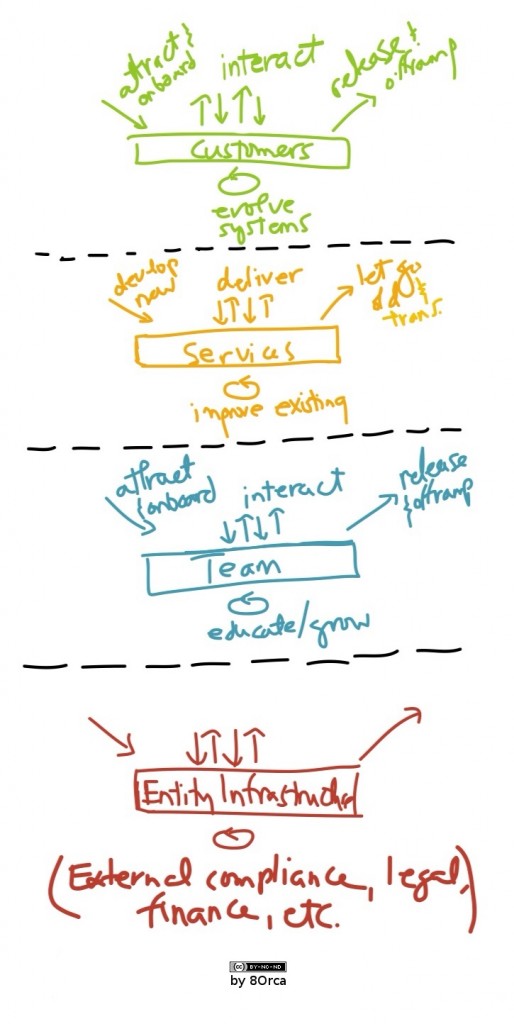A few years ago, I was working on the interior components of our firm, and there were so many different ideas coming at me, that I had a hard time putting them all in context. I started to think about it: is there a way to see the firm from a bird’s eye view that can help me keep track and prioritize what’s changing, what’s not changing, what needs to be different, what should be left alone, etc? Thus was born the accounting firm process model.
Processes aren’t strategy per se; they aren’t your business model exactly, nor your organizational structure by itself. Processes are simply the way things get done. They get touched by, and touch all these other elements, so they need to live and breathe with your “why.” But having a place where basic steps are outlined goes a far way to enabling you to effectively help your customers.
The four key elements of the accounting firm process model are: Customers, Services, Team, and Entity. For me, every key process I had could be categorized into one of these four groups. And each of the four key elements can be added to, subtracted from, interacted with, or evolved.
So for example, for the Customers element, I’ve got my “Attract & Onboard” component, my “Interact” component, my “Release & Offramp” component, and my “Improve” component. “Attract & Onboard” is where we list out how we reach out to new customers (be it print advertising, social media, etc.), what we do on “first contact” from a prospective customer, the notes for conducting our value conversation, our template customer agreements, how we setup the customer in our contact management systems, etc. “Interact” is where we list how we answer phone calls, how change requests get handled, the steps for renewing customer agreements, processing customer payments, etc. “Release & Offramp” is where we cover what to do if a customer says they want to end their agreement, how we internally identify who may not be a good fit for us, pointers for archiving customer records from our various data systems, etc. And “Improve” is how we go about making each of these components better.
The last one is especially important. As I mentioned above, your processes need to live and breathe with your “why.” It’s critically important that you see and treat them as living, organic, and evolving. I made this argument in The Firm(s) of the Future(s), where I suggested that the firms of the future will be the ones who have developed the ability to develop — that we need to build, the ability to build, right into our systems. Designing your processes in this way serves a two-fold purpose: One, you can get started on them right away since they don’t have to be in a completed state to “publish” (I know all of us certainly aren’t). And two, they’re continually open-ended: as you follow a process and are learning, you have a way to fold that new knowledge back into your process to make it better for next time. Powerful stuff, powerful stuff indeed.
Now allow me to weave one more thread back through this tapestry: Channeling Creativity. You may remember in that post I talked about how having a mechanism to capture and record ideas helps keep the creative process from gumming up, or losing direction. The Evernote mechanism I briefly described there is patterned after the model above: I have Evernote notebooks for Customers, Services, Team, and Entity. And anytime I have an idea that touches one of those four areas, I make a note record, and store it in the related notebook. And as my mind fleshes out those ideas over time, I add the additional details. And when I’m ready to deploy that idea, I bring it to my focus notebook (I call it Single Stream), hack on it for awhile, then roll it out. Rinse, repeat. For me, this has been tremendously helpful because I have a framework for capturing good ideas so they don’t slip by, but a frame for helping place those ideas in context so I can prioritize, pick and choose, and focus only what needs focus next.
There’s more that can be said, of course, but I hope you can see how this model functions. If this concept is helpful to you, or if you have questions or thoughts about it, please let me know in the comments below — I’d love to hear from you. And if there’s any one revelation to me, it’s that processes need to be organic — it’s harder, but the only sustainable way to grow a firm. If you need any proof, just check out this video about Grocery Wars. ‘Til next time…
(As originally posted on the Thriveal blog.)

